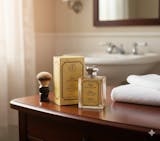Where To Buy Straight Razor And What’s The Best One For You

Buying straight razors for men can be overwhelming due to the multitude of choices available. With various sizes and materials, it's crucial to have a guide to narrow down options and avoid the misconception that any razor will suffice.
Unlike disposable cartridges, the quality of your straight razor significantly impacts your clean shave, making the selection process, including factors like price, style, grind, and blade temper, a crucial consideration.
At Naked Armor, we provide up-to-date guidelines for both straight razor beginners and experts, offering essential information to help you make an informed choice to start your wet shaving journey.
- What is a Straight Razor Made Of?
- Guidelines for Buying a Straight Razor
- Straight Razor Styles
- Caring for Your Straight Razor
- Where to Buy Straight Razor
What is a Straight Razor Made Of?
The popularity of disposable razors made straight razor shaving into something intimidating despite its rich history as the first razor dating back to Ancient Egypt. A straight razor, crafted meticulously by hand through forging, hardening, and honing, offers optimal strength and a cut-throat edge. This craftsmanship distinguishes it from mass-produced modern alternatives like disposable and cartridge razors with replaceable blades.
Not to mention, straight razor manufacturers go beyond using plastics and cheap steel. Like the one from Naked Armor, the best straight razors use high-quality steel for the blades and hardwood for their scales.
Straight Razor Parts Index
A typical razor, like disposable razors and safety razors, has three main parts: the blade, handle, and head. On the other hand, straight razors feature 13 different parts, which are:
- Pivot pin - connecting peg between the scales and the razor blade
- Scales - official term for a straight razor handle
- Tang - other end of the blade for balancing or stabilizing the finger
- Shank - binding metal section between the blade and the pivot pin
- Jimps - ridges or “fluting” under the shank assisting better grip on the underside of the shank
- Shoulder - end of a straight razor blade or the section between the shank and spine
- Spine - top side of the blade
- Point - straight razor blade’s profile or flat end
- Face - blade’s side surface that can be customized with logos, initials, and other decorations
- Toe - endpoint of the blade’s cutting edge or sharp edge
- Edge - straight razor blade’s cutting edge or sharp cut-throat surface
- Heel - area under the shoulder, connecting the heel and shank, aiming to protect the thumb
- Stabilizer - embossed area between the shoulder and heel
Learning the parts of straight razors is key in finding the right shaving technique to get the nick-free, smooth, close shave all shavers deserve. Here at Naked Armor, we have previously discussed the parts of a straight razor. You can refer to that if you wish to have a more in-depth knowledge of each section.
Grinds of a Straight Razor
The shape of the blade’s cross-section is called a grind. It is among the crucial factors most straight razor neophytes often overlook when buying straight razors.
Coincidentally, not many are aware of its importance, not unless they have long been an enthusiast or a professional barber.
Here are the basic grinds of a straight razor:
-
Wedge grinds
A wedge grind in razor blades is defined by a flat or straight cross-section, seen in many vintage razors. This design results in a heavier blade, making it more suitable for cutting thicker hair despite posing a greater challenge for a smooth glide on the skin.
-
Hollow grinds
A straight razor with a hollow grind features a concave shape achieved by removing steel from the blade's sides. This design provides increased flexibility and a lighter mass, offering easier control during shaving and reduced pressure on the face.
The grind of a straight razor is a key factor for pros to gauge its quality. It influences how the razor sits on your face during shaving, offering an idea of how easy it is to avoid cutting your skin and irritation, especially for beginners.
Know more about straight razor grinds through this guide.
Guidelines for Buying a Straight Razor
Now that you're familiar with the basic types and parts of straight-edge razors, let's explore the essential factors to consider when choosing the best straight razor.
1. Choose a Straight Razor with a Wooden Scale
The handle or scales1 of a straight razor typically have two strips held together by brass pins and washers, allowing for pivoting. While historic razors had opulent scales made of horns and exotic wood, modern ones often use celluloid, stainless steel, or timber wood.
At Naked Armor, we advocate for wooden handles, particularly sandalwood, for their classy appearance and comfortable feel. Our razors retain sandalwood's natural oils, providing therapeutic benefits during use.
2. Choose a Stainless Steel Blade
A straight razor made of stainless steel is perfect for beginners compared to the other usual choice–carbon steel, because it offers lasting sharpness, rust resistance, and easy cleaning. But, do note that a sharp edge can dull due to unprecedented factors2 such as shaving angles and microscopic chips.
Choosing a high-quality blade, like Japanese stainless steel (61-65 HRC) at Naked Armor, is crucial. Although stainless steel requires more effort to hone, its prolonged sharpness reduces the need for frequent honing.
3. Pick a Blade with a Dutch Point
A razor blade with a Dutch endpoint is best for first-time users for safety reasons. It wears a rounded edge, protecting you from nicks, cuts, and other possible injuries while shaving. Hence, its edge is a great tool to use for easing oneself into a straight razor shaving experience.
In terms of practicality, the Dutch’s round point is more forgiving to sudden changes in angle or direction, so one gets fewer chances of getting significant nicks and cuts.
4. Pick a Blade with the Right Size
The size of a straight razor blade or blade width can influence its weight and feel in your hand. Razor heights vary from 8/8 inch (largest) to 3/8. Those with thicker beards prefer larger sizes, while 3/8 sizes are suitable for mustache trimming. Generally, a 5/8 or 7/8 blade is an ideal starting size for most users.
5. Get the Correct Grind
Razors come in various grinds for different purposes, but most pros suggest the hollow grind for the average shaver. Hollow ground blades are thin, making them easy to use and maintain, while a full wedge grind is better for thicker beards and heavy-duty shaving.
6. Consider a Shave Kit Instead of Just a Straight Razor
 Naked Armor's Straight Razor Kit is an ideal choice for beginners, providing everything you need for a smooth start to wet shaving.
Naked Armor's Straight Razor Kit is an ideal choice for beginners, providing everything you need for a smooth start to wet shaving.
And while you are at it, why not buy a straight razor shaving kit instead? A kit already comes with straight razors and other shaving products that help you enjoy a good straight razor shave. It is a great way to get the best bang for your buck.
When purchasing a straight-edge razor, prioritize stainless steel for durability, a Dutch point for safety and precision, a 7/8 size for ease of use, and a hardwood scale to balance the blade's weight and provide a comfortable grip.
Straight Razor Styles
Straight razors come in various styles, including the pivoted design of Sweeney Todd's cut-throat razor, the shavette favored by barbers, and the oriental Kamisori. Each style provides a unique shaving experience and requires distinct techniques, making them non-alternative choices to one another.
- Traditional Straight Razor: This is the classic foldable razor that most people envision when they think of straight razors.
- Shavette: A shavette is a variation that uses disposable blades or double-edge razor blades,3 making it easier to maintain for beginners.
- Kamisori: Originating from Japan, the kamisori is a single-edged razor with a distinctive asymmetrical shape.4
Deciding on the best straight-edge razor for beginners can be confusing. Some suggest avoiding shavettes because they're smaller and need a different technique. Instead, starting with a Kamisori is recommended as it's similar in size to traditional razors and is practical for learning how to use a straight razor and maintain it.
Caring for Your Straight Razor
 Regular stropping, occasional honing every three to six months, and careful use of sharpening paste are crucial for maintaining an expensive straight razor.
Regular stropping, occasional honing every three to six months, and careful use of sharpening paste are crucial for maintaining an expensive straight razor.
Investing in an expensive straight razor doesn't guarantee longevity; proper care, including learning to sharpen, regular stropping, and occasional honing, is crucial for maintaining a durable and effective razor.
- Stropping: A process of maintenance featuring a leather strop that buffs the minor chips on your blade's edge, keeping the big ones at bay.
- Honing: When a strop can't revive the razor's edge, honing stones, used every three to six months, become the last resort for maintaining sharpness.
- Sharpening Paste: Adding finer grit to the strop, it helps restore the razor blade's edge, steel finish, and shine; however, if your strop is effective, avoid this to maintain quality.
You can further know the specifics needed to maintain the sharp blade of your straight razor through our more in-depth article on how to sharpen a straight razor. Everything you need to know about honing, stropping, grits, and other sharpening essentials is there.
Where to Buy Straight Razor
 Naked Armor's Merlin Straight Razor is among the best, boasting a durable full stainless steel design from blade to scales.
Naked Armor's Merlin Straight Razor is among the best, boasting a durable full stainless steel design from blade to scales.
Many straight razors are handcrafted, often making them an exclusive purchase. And though they are less common than the grocery-staple disposable razors, locating a straight razor nearby is not that challenging. From brick-and-mortar establishments to digital outlets, we're guiding you to discover the most accessible and trustworthy straight razor shop.
- Barber Recommendations: Ask the pros where to find excellent straight razors that work well. Your barber knows their stuff, so it's a smart idea to get their advice.
- Online Shopping Platforms: Online websites like Amazon and Etsy have a bunch of different straight razors with real reviews to help you pick the right one.
- Vintage Shops: Antique stores often showcase straight razors with history and proven quality despite needing a bit of tender loving care, making them ready for a lifetime of service. And if you happen to snag a vintage razor, our Master Honing Service is here to help restore your old straight razor to its former glory.
- Flea Markets: Shops here offer artisanal straight razors that can be crafted for a design perfectly tailored to your shaving needs.
- Online Shaving Outlets: Online shaving outlets, such as Naked Armor, are convenient one-stop shops for men's grooming needs with a diverse collection of carefully curated straight razors from trusted brands like Thiers Issard, DOVO, and others worldwide, ensuring you get the best quality for the closest shave.
At Naked Armor, you can shop one of the most top-rated, shave-ready straight razors within a shaving set tailored to your expertise. For beginners, the Merlin 7/8" Straight Razor is the best choice. It is a complete 7-piece shaving set with everything you need in a straight razor kit. Plus, the razor boasts a beginner-friendly round point, hollow grind, and stainless steel blade that is durable, wear-resistant, and easy to clean.
More Naked Armor Reads
Best Straight Razor Dimensions & Sizes For Beginners
Beginner's Guide to Straight Razor Shaving
How To Hold Straight Razors: Grips, Angle, and Shaving Direction






























Leave a comment